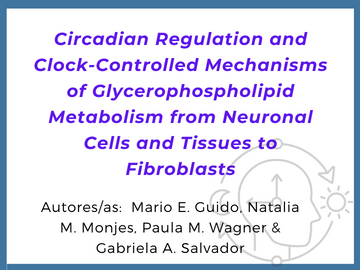Circadian Regulation and Clock-Controlled Mechanisms of Glycerophospholipid Metabolism from Neuronal Cells and Tissues to Fibroblasts
Abstract
Along evolution, living organisms developed a precise timekeeping system, circadian clocks, to adapt life to the 24-h light/dark cycle and temporally regulate physiology and behavior. The transcriptional molecular circadian clock and metabolic/redox oscillator conforming these clocks are present in organs, tissues, and even in individual cells, where they exert circadian control over cellular metabolism. Disruption of the molecular clock may cause metabolic disorders and higher cancer risk. The synthesis and degradation of glycerophospholipids (GPLs) is one of the most highly regulated metabolisms across the 24-h cycle in terms of total lipid content and enzyme expression and activity in the nervous system and individual cells. Lipids play a plethora of roles (membrane biogenesis, energy sourcing, signaling, and the regulation of protein-chromatin interaction, among others), making control of their metabolism a vital checkpoint in the cellular organization of physiology. An increasing body of evidence clearly demonstrates an orchestrated and sequential series of events occurring in GPL metabolism across the 24-h day in diverse retinal cell layers, immortalized fibroblasts, and glioma cells. Moreover, the clock gene Per1 and other circadian-related genes are tightly involved in the regulation of GPL synthesis in quiescent cells. However, under proliferation, the metabolic oscillator continues to control GPL metabolism of brain cancer cells even after molecular circadian clock disruption, reflecting the crucial role of the temporal metabolism organization in cell preservation. The aim of this review is to examine the control exerted by circadian clocks over GPL metabolism, their synthesizing enzyme expression and activities in normal and tumorous cells of the nervous system and in immortalized fibroblasts.
Mario E. Guido, Natalia M. Monjes, Paula Wagner, Gabriela A. Salvador
Molecular Neurobiology 59, 326–353 (2022). https://doi.org/10.1007/s12035-021-02595-4

